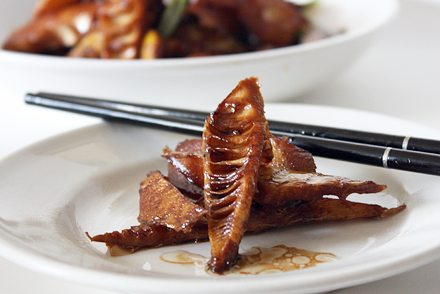Common braising methods introduced, along with a tasty recipe
Via Redcook.net.
A Chinese children fable called “Spring Bamboo Shoot and the Pebbles” (《春笋与乱石》 chūnsǔn yǔ luànshí) tells a story of a spring bamboo shoot aspiring to burst through the soil, but is halted by a group of pebbles above him. He politely asks the pebbles to let him through but to no avail. With shear determination he pushes through between the pebbles and grows out of the soil. The pebbles are so impressed that they start celebrating him as a superstar. I’m actually not quite sure what the moral of the story is. But “success through determination” is so typically Chinese and very tiger-mom like. Regardless of the moral though, the story does tell of how bamboo shoots surge forth every spring to produce one of the most delicately delicious ingredients in Chinese cooking.
Spring bamboo shoot is the young shoot that has broken through the soil and appears above ground, as opposed to winter bamboo shoots that are harvested while they are still in the ground. The tip of the shoot is incredibly tender and sweet. That’s the reason why they are eagerly anticipated during the few months they are available in the spring. Last weekend I noticed them for the very first time being sold in New York City. I was thrilled to find them at Jmart in the New World Mall in Flushing. They still appeared succulent and fresh in spite of being transported all the way from Asia. So I bought some and cooked them for dinner last night.
Although there are many ways to prepare spring bamboo shoots, I usually like to make it using a simple technique known as oil braising. The shoots are first fried until they just begin to turn brown, then braised in an aromatic soy sauce liquid until the flavors are thoroughly absorbed into the shoots.


Braising is a very important technique in Chinese cooking. In fact it is so complex that it can be classified further into many different variations. Without getting into too much detail, I’d like to present the five most common braising methods that include red cooking (红烧 hóngshāo), white braising (燉 dùn), soup braising (煨 wēi), oil braising (焖 mèn) and flavor potting (卤 lǔ).
With red cooking the ingredient is parboiled then slow cooked in a soy sauce braising liquid. White braising is the same process but using an aromatic non soy sauce liquid. On the other hand soup braising and oil braising both pre-fry the ingredients before slow cooking. Oil braising uses a soy sauce based liquid, while in soup braising the liquid is non soy sauce based. Soup braising is also characterized by the large quantity of liquid during cooking and resembles a soup at the end.
And finally the last method, known as flavor potting, is uniquely Chinese. With this method the soy sauce based braising liquid is used from one cooking to the next. Each time the liquid is reused the flavor becomes deeper and more robust. There are restaurants in China that claim to have used the same flavor potting liquid uninterrupted for more than a hundred years. Personally I doubt this assertion since during the Cultural Revolution there was so much disruption in people’s daily life that saving braising liquid would not have been a priority.



So having decided to braise the spring bamboo shoots they need to be prep. The easiest way to remove the sheaths on the outside is to cut the shoot in half lengthwise first. Then holding the bottom of the shoot in one hand, twist the top to peel off all the layers of sheathing with the other hand. Once cleaned the shoots should be boiled in water to eliminate the slightly bitter and astringent quality. You can then go ahead and braise the bamboo shoots as instructed in the following recipe.
I’m not sure that the moral of the spring bamboo shoots fable is that practical for Chinese kids today. Being determined and independent can only run afoul of the Communist authority. Still it’s a fun story to tell your kids while enjoying this spring bamboo treat.
Oil Braised Spring Bamboo Shoots (油焖春笋 yóu mèn chūnsǔn)
- 1 pound spring bamboo shoots (about 2 pounds with the outer sheath)
- 1 teaspoon Sichuan peppercorns
- 1 tablespoon sugar
- 2 tablespoons dark soy sauce
- 1/4 cup Shaoxing cooking wine
- 1/2 cup vegetarian stock (or water)
- 1 cup vegetable oil
- Finely chopped scallion for garnish
Cut each bamboo shoot in half lengthwise. Then twist the shoot to loosen and remove the sheath from the heart. Cut off the dried bottom of the shoot.
Put the bamboo shoots into a medium 4-quart stockpot. Add enough water to cover. Gently boil for about ten minutes.
Drain the bamboo shoots thoroughly and cut them into small irregular shaped pieces of about 1-inch wide.
Heat the vegetable oil in a wok until it is just about to smoke or 350 degrees F. Deep fry the bamboo shoots about five minutes or until the edges begin to brown.
Drain the bamboo shoots and set aside.
Remove all but 2 tablespoons of the vegetable oil from the wok. Add the Sichuan peppercorns and cook over medium heat for about three minutes to infuse its flavor into the oil. Remove the Sichuan peppercorns.
Return the bamboo shoos to the wok and add sugar, dark soy sauce, Shaoxing cooking wine and vegetarian stock. Braise covered over low heat for about twenty minutes.
Uncover and continue to cook until the sauce has reduced to the point that it just coats all the bamboo shoots.
Plate and serve immediately garnished with chopped scallion.
Written by: Kian Lam Kho
Image Courtesy of Redcook.net
In addition to bamboo shoots, bamboo can do pretty much anything in China!












